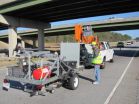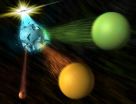(Press-News.org)
VIDEO:
Researchers from the Georgia Tech Research Institute developed an prototype automated pavement crack detection and sealing system.
Click here for more information.
Sealing cracks in roadways ensures a road's structural integrity and extends the time between major repaving projects, but conventional manual crack sealing operations expose workers to dangerous traffic and cover a limited amount of roadway each day.
To address these challenges, the Georgia Tech Research Institute (GTRI) developed a prototype automated pavement crack detection and sealing system with funding from the Georgia Department of Transportation. In road tests, the system was able to detect cracks smaller than one-eighth-inch wide and efficiently fill cracks from a vehicle moving at a speed of three miles per hour.
"Our prototype system has proved in many ways that a commercial-scale automated crack sealing system is viable," said Jonathan Holmes, the GTRI research engineer currently leading the project, which began in 2003. "We demonstrated solutions to technical challenges -- including the high-speed firing of nozzles, automated crack detection and navigation -- in a real-time, limited-scale system."
An automated crack sealing system would increase the level of safety for the workers involved, require fewer personnel and increase the amount of roadway covered per day. In addition, the system could save transportation departments money because sealing cracks extends the time before a roadway needs to be completely repaved.
The prototype system, which was mounted on a trailer, consists of a stereo camera, light-emitting diodes (LEDs) of two different colors, and an assembly to provide a continuous supply of sealant to longitudinal and transverse sealant distribution systems. The operation required only one worker to drive the vehicle pulling the trailer.
As the system traveled along a road lane, the LEDs illuminated the road in two directions -- parallel and perpendicular to the road -- and the stereo camera took two pictures of the road simultaneously, which were analyzed using thresholding and filtering algorithms. Within 100 milliseconds of taking the images, the computer onboard the trailer generated a "crack map" specifying the location and shape of any cracks shown in the images.
Based on the cracks found in the image, the master controller instructed the sealant applicator valves when to fire. To fill longitudinal cracks, a single dispensing nozzle capable of continuous operation was attached to a linear servo axis. The transverse sealant distribution system consisted of 12 nozzles spaced evenly across one foot. The transverse and diagonal distribution prototype was intended to represent one module that could be replicated and joined together to service a full-width roadway lane.
In multiple road tests, the prototype system proved to be a successful proof-of-concept for the automation of crack sealing operations.
Before a full-scale system can be successfully implemented by transportation departments, several issues must be addressed, according to Holmes. First, the crack detection algorithm will need to be improved. The researchers tested their crack detection algorithm on more than 100,000 images they collected of cracks on state roads and found the program correctly identified more than 83 percent of the cracks.
"Our crack detection algorithm was limited because we used a vision-based system, which was confounded by regions of high contrast caused by features other than pavement cracks, including dark stains in the pavement, lane stripes, raised-pavement markers, crack sealant and debris," said Holmes. "A full-scale system may require a fusion of multiple imaging sensors, such as a 3-D laser scanning system."
Holmes also suggested changes will be necessary in the way the sealant was supplied to the longitudinal and transverse distribution systems before a full-scale system can be realized.
INFORMATION:
David Jared, acting chief of research & development at the Georgia Department of Transportation Office of Materials and Research, and GTRI principal research engineers Wayne Daley and Wiley Holcombe, research scientist Colin Usher, and research engineers Sergio Grullon and Steven Robertson also worked on this project.
The contents of this publication reflect the views of the principal investigators who are responsible for the facts and accuracy of the data presented herein. The contents do not necessarily reflect the official view or policies of the Department of Transportation, State of Georgia or the Federal Highway Administration. This publication does not constitute a standard, specification or regulation.
GTRI researchers develop prototype automated pavement crack detection and sealing system
2012-06-19
ELSE PRESS RELEASES FROM THIS DATE:
Study improves understanding of surface molecules in controlling size of gold nanoparticles
2012-06-19
North Carolina State University researchers have shown that the "bulkiness" of molecules commonly used in the creation of gold nanoparticles actually dictates the size of the nanoparticles – with larger so-called ligands resulting in smaller nanoparticles. The research team also found that each type of ligand produces nanoparticles in a particular array of discrete sizes.
"This work advances our understanding of nanoparticle formation, and gives us a new tool for controlling the size and characteristics of gold nanoparticles," says Dr. Joseph Tracy, an assistant professor ...
Children, brain development and the criminal law
2012-06-19
The legal system needs to take greater account of new discoveries in neuroscience that show how a difficult childhood can affect the development of a young person's brain which can increase the risk adolescent crimes, according to researchers. The research will be presented as part of an Economic and Social Research Council seminar series in conjunction with the Parliamentary Office of Science and Technology.
Neuroscientists have recently shown that early adversity – such as a very chaotic and frightening home life – can result in a young child becoming hyper vigilant ...
Yankee fans keep enemy Red Sox closer, NYU study shows
2012-06-19
Fans of the New York Yankees incorrectly perceive Fenway Park, home of the archrival Boston Red Sox, to be closer to New York City than is Camden Yards, home of the Baltimore Orioles, a study by New York University psychologists has found. Their research, which appears in the Personality and Social Psychology Bulletin, shows how social categorization, collective identification, and identity threat work in concert to shape our representations of the physical world.
"Sun Tzu, the Chinese military general, philosopher, and author of what is arguably the most famous book ...
Helping superconductors turn up the heat
2012-06-19
VIDEO:
University of Miami physics professor Josef Ashkenazi discusses supercooling with liquid nitrogen and superconductors.
Click here for more information.
CORAL GABLES, FL (June 18, 2012)--Researchers from the University of Miami (UM) are unveiling a novel theory for high-temperature superconductivity. The team hopes the new finding gives insight into the process, and brings the scientific community closer to achieving superconductivity at higher temperatures than currently ...
BaBar data hint at cracks in the Standard Model
2012-06-19
Menlo Park, Calif. — Recently analyzed data from the BaBar experiment may suggest possible flaws in the Standard Model of particle physics, the reigning description of how the universe works on subatomic scales. The data from BaBar, a high-energy physics experiment based at the U.S. Department of Energy's (DOE) SLAC National Accelerator Laboratory, show that a particular type of particle decay called "B to D-star-tau-nu" happens more often than the Standard Model says it should.
In this type of decay, a particle called the B-bar meson decays into a D meson, an antineutrino ...
Science of parenting, the link between sexism and racism, death and the supernatural, and more
2012-06-19
Story leads this month from new articles on parenting by the norm, the link between sexism and racism, death and the supernatural, how brands shape identity and more...
Parenting by the social norm
For parents, it is not only important to pass on to their children values that they personally endorse but also to teach values that they think are the societal norms, according to a new study. Particularly among immigrant parents, conforming to values that they perceive as norms is important. "Intersubjective Model of Value Transmission: Parents Using Perceived Norms as ...
Presidential candidates should address childhood obesity and bullying, poll says
2012-06-19
ANN ARBOR, Mich. – During this presidential election season, there will be plenty of debate between the candidates on the issues. But when it comes to childhood health concerns, a new poll shows many adults agree on the top priorities they want to see the candidates address: childhood obesity and bullying.
The University of Michigan C.S. Mott Children's Hospital National Poll on Children's Health recently asked adults to name the top child health concerns that the presidential candidates should address.
In a survey of more than 2,100 adults, participants selected the ...
Study indicates promise in Huntington's treatment
2012-06-19
A new study shows that the compound Coenzyme Q10 (CoQ) reduces oxidative damage, a key finding that hints at its potential to slow the progression of Huntington disease. The discovery, which appears in the inaugural issue of the Journal of Huntington's Disease, also points to a new biomarker that could be used to screen experimental treatments for this and other neurological disorders.
"This study supports the hypothesis that CoQ exerts antioxidant effects in patients with Huntington's disease and therefore is a treatment that warrants further study," says University ...
Experts recommend men at risk for osteoporosis undergo bone density testing
2012-06-19
Chevy Chase, MD—Osteoporosis in men causes significant morbidity and mortality. Today, the Endocrine Society released clinical practice guidelines (CPG) for management of this condition in men. "Osteoporosis in Men: An Endocrine Society Clinical Practice Guideline," is published in the June 2012 issue of the Journal of Clinical Endocrinology and Metabolism (JCEM), a publication of The Endocrine Society.
Osteoporosis is a silent disorder characterized by reduced bone strength predisposing to increased fracture risk. Approximately 20 percent of Americans with osteoporosis ...
New studies hint at possible approaches to protect those at risk for Huntington's disease
2012-06-19
Amsterdam, NL, 19 June 2012 – In Huntington's disease, abnormally long strands of glutamine in the huntingtin (Htt) protein, called polyglutamines, cause subtle changes in cellular functions that lead to neurodegeneration and death. Studies have shown that the activation of the heat shock response, a cellular reaction to stress, doesn't work properly in Huntington's disease. In their research to understand the effects of mutant Htt on the master regulator of the heat shock response, HSF1, researchers have discovered that the targets most affected by stress are not the ...


